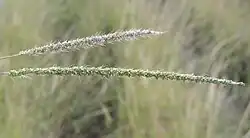Setaria vulpiseta
| Setaria vulpiseta | |
|---|---|

| |
| Scientific classification | |
| Kingdom: | Plantae |
| Clade: | Tracheophytes |
| Clade: | Angiosperms |
| Clade: | Monocots |
| Clade: | Commelinids |
| Order: | Poales |
| Family: | Poaceae |
| Subfamily: | Panicoideae |
| Genus: | Setaria |
| Species: | S. vulpiseta
|
| Binomial name | |
| Setaria vulpiseta | |
| Synonyms[1] | |
| |
Setaria vulpiseta is a species of grass known by the common name plains bristlegrass.[2] It is native to North America, where it occurs in Texas to Colorado to Arizona in the United States and northern and central Mexico.[3]
This perennial grass grows up to 3[3] to 4 feet tall.[4] It is yellow in color when mature. The hairy leaves are up to 10 inches long and have a ligule of hairs. The inflorescence is up to 5 inches long and is very narrow.[4]
This grass is a common forage in the American southwest. It is good grazing for livestock. The seed provides food for wildlife.[3] Its natural habitat is dry rangeland as well as low plains that receive flooding.[4]
References
- ^ "The Plant List: A Working List of All Plant Species". Retrieved 14 December 2014.
- ^ NRCS. "Setaria vulpiseta". PLANTS Database. United States Department of Agriculture (USDA). Retrieved 11 November 2015.
- ^ a b c Setaria vulpiseta. USDA NRCS Plant Fact Sheet.
- ^ a b c Setaria vulpiseta. USDA NRCS Plant Guide.